|
|
|
Sort Order |
|
|
|
Items / Page
|
|
|
|
|
|
|
| Srl | Item |
| 1 |
ID:
048233
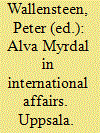

|
|
|
|
|
| Publication |
Uppsala, Uppsala University, 2003.
|
| Description |
83p.Pbk
|
| Standard Number |
9170052662
|
|
|
|
|
|
|
|
|
|
|
|
Copies: C:1/I:0,R:0,Q:0
Circulation
| Accession# | Call# | Current Location | Status | Policy | Location |
| 047195 | 923.209485/WAL 047195 | Main | On Shelf | General | |
|
|
|
|
| 2 |
ID:
065953
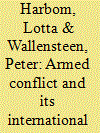

|
|
|
| 3 |
ID:
073583
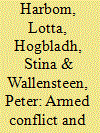

|
|
|
| 4 |
ID:
109916
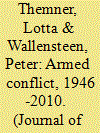

|
|
|
|
|
| Publication |
2011.
|
| Summary/Abstract |
In 2010, UCDP recorded 30 active armed conflicts (i.e. with a minimum of 25 battle-related deaths). This is a substantial reduction in relation to the 36 conflicts registered for 2009. A drop of this magnitude has only been reported four times previously in the post-1946 period. However, only in two of these instances was this part of a general downward trend. Thus no major inferences should be drawn, except perhaps that the reduction in conflicts in Africa seems to be part of a trend. At 30 in 2010, the number of active conflicts is at its lowest level since 2003. Furthermore, the number of wars (1,000 or more battle-related deaths) declined from six in 2009 to four in 2010. The most intense war in terms of fatalities was in Afghanistan. Eight of the armed conflicts listed for 2009 were not active in 2010, but during the year two new conflicts erupted - Mauritania and Tajikistan - both involving rebel groups that had previously fought in neighbouring countries. Only two peace agreements were concluded during the year. While this is one more than 2009, it is decidedly below the annual average for the post-Cold War period.
|
|
|
|
|
|
|
|
|
|
|
|
|
|
|
|
| 5 |
ID:
090141
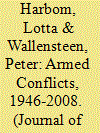

|
|
|
|
|
| Publication |
2009.
|
| Summary/Abstract |
In 2008, the number of active armed conflicts was 36, up by one from 2007. Over the past few years, the number of active conflicts has not seen any drastic changes from one year to the next. However, the number of armed conflicts has increased by nearly one-quarter since 2003, which was the year with the lowest number of active armed conflicts since the 1970s. While the number of conflicts continued to increase, the number of wars (i.e. conflicts with over 1,000 battle-related deaths) remained at a very low level, with only five recorded for 2008. Four conflicts listed in 2007 were no longer active in 2008, but during the year, two conflicts were restarted by previously recorded actors (in Burundi and in Georgia). Furthermore, three new conflicts erupted, one of which was fought between states (Djibouti-Eritrea). Thus, the record-long four-year interlude 2004-07 with no interstate conflict was broken.
|
|
|
|
|
|
|
|
|
|
|
|
|
|
|
|
| 6 |
ID:
098418
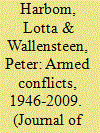

|
|
|
|
|
| Publication |
2010.
|
| Summary/Abstract |
In 2009, UCDP recorded 36 active armed conflicts, down by one from 2008. Having remained fairly stable over the past few years, the number of armed conflicts is now substantially lower than during the peak years of the early 1990s. But compared to the early years of this decade, the figure has increased by 24%. Six of the conflicts reached the level of war (more than 1,000 battle-related deaths) in 2009, up by one from 2008. No interstate conflict was recorded, but seven intrastate conflicts were internationalized, in the sense that one or both of the conflict parties received troops support from an external state. The most intense war in terms of fatalities was that in Sri Lanka. Eight of the armed conflicts listed for 2008 were not active in 2009, but during the year, one entirely new conflict erupted in Myanmar (Kokang), two were restarted by previously recorded actors in Angola (Cabinda) and in Rwanda and four previously recorded conflicts were restarted by new actors in Central African Republic, India (Bodoland), Nigeria and Yemen. Only one peace agreement was concluded during the year, which is decidedly lower than the annual average recorded for the past 20 years.
|
|
|
|
|
|
|
|
|
|
|
|
|
|
|
|
| 7 |
ID:
117019


|
|
|
|
|
| Publication |
2012.
|
| Summary/Abstract |
In 2011, the Uppsala Conflict Data Program (UCDP) recorded 37 armed conflicts with a minimum of 25 battle-related deaths. This significant increase from the 31 conflicts recorded in 2010 was primarily driven by an increase in conflicts on the African continent, and is only in part due to events tied to the Arab Spring which mostly led to other forms of violence than conventional armed conflict. The number of active conflicts still remains at a relatively low level compared to the peak years in the early 1990s, when more than 50 conflicts were active. The number of wars - conflicts leading to 1,000 or more battle-related deaths - increased to six; however, it is a considerably lower number than during the peak years of the early 1990s. For the second consecutive year, Afghanistan claimed the highest number of fatalities. Five armed conflicts listed for 2010 were not active in 2011, but during the year three new conflicts erupted - Libya, South Sudan and Sudan (Abyei) - and six conflicts already registered were restarted. Only one peace agreement was concluded during the year. Thus, the trend with low numbers of peace accords which started in 2009 continues.
|
|
|
|
|
|
|
|
|
|
|
|
|
|
|
|
| 8 |
ID:
122902
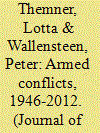

|
|
|
|
|
| Publication |
2013.
|
| Summary/Abstract |
In 2012, the Uppsala Conflict Data Program (UCDP) recorded 32 armed conflicts with a minimum of 25 battle-related deaths. This is a significant decrease from the 37 recorded in 2011. Overall, the 2000s has been the least conflict-ridden decade since the 1970s. A worrying finding, however, is that the number of internationalized intrastate conflicts continued to be at a high level for the fourth consecutive year. At six, the number of wars - conflicts leading to 1,000 or more battle-related deaths - remained the same as in 2011. In total, UCDP estimates that the conflicts that were active in 2012 caused between 37,175 (low estimate) and 60,260 (high estimate) battle-related deaths, with a best estimate of 37,941. The conflict that caused the highest number of fatalities in 2012 is the Syrian conflict, which led to between 14,830 (low) and 30,805 (high) battle-related deaths, with the best estimate being 15,055. Eleven armed conflicts listed in 2011 were not active in 2012; however, three new conflicts erupted during the year - India (Garoland), Mali and South Sudan vs. Sudan (common border) - and three previously registered conflicts were resumed by new actors. Lastly, 2012 saw an increase in the number of signed peace agreements which had been at a very low level over the past three years; four accords were concluded during the year, compared with one in 2011.
|
|
|
|
|
|
|
|
|
|
|
|
|
|
|
|
| 9 |
ID:
133711
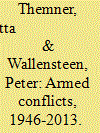

|
|
|
|
|
| Publication |
2014.
|
| Summary/Abstract |
In 2013, the Uppsala Conflict Data Program (UCDP) recorded 33 armed conflicts with a minimum of 25 battle-related deaths, up by one from 2012. Seven of these were recorded as wars, that is conflicts leading to 1,000 or more battle-related deaths in a calendar year. There have been 144 armed conflicts (47 wars) since 1989 and 254 armed conflicts (114 wars) since 1946. For the past ten years the amount of active armed conflict has fluctuated between 31 and 37. Six peace agreements were signed during the year 2013, two more than in the previous year. For the first time, this article also provides data on trends in battle-related deaths since 1989. These data do not show a clear time-trend. However, there is a particular difficulty in mapping the conflict in Syria, for which no credible battle-related deaths in 2013 can yet be reported.
|
|
|
|
|
|
|
|
|
|
|
|
|
|
|
|
| 10 |
ID:
049419
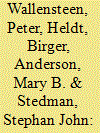

|
|
|
|
|
| Publication |
Uppsala, Department of Peace and Conflict Research, Uppsala University, 2001.
|
| Description |
60p.
|
| Series |
Research report; no. 59
|
| Standard Number |
9150615130
|
|
|
|
|
|
|
|
|
|
|
|
Copies: C:1/I:0,R:0,Q:0
Circulation
| Accession# | Call# | Current Location | Status | Policy | Location |
| 045203 | 303.69/WAL 045203 | Main | On Shelf | General | |
|
|
|
|
| 11 |
ID:
041234
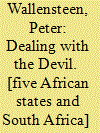

|
|
|
|
|
| Publication |
Uppsala, Department of Peace and Conflict Research, Uppsala University, 1971.
|
| Description |
85-99p.
|
|
|
|
|
|
|
|
|
|
|
|
Copies: C:1/I:0,R:0,Q:0
Circulation
| Accession# | Call# | Current Location | Status | Policy | Location |
| 016825 | 327.60068/WAL 016825 | Main | On Shelf | General | |
|
|
|
|
| 12 |
ID:
088758


|
|
|
|
|
| Publication |
2009.
|
| Summary/Abstract |
The awarding of the 2008 Nobel Peace Prize to former President Martti Ahtisaari, Finland, cites his involvement in the settlement of the Aceh conflict. This at the same time highlights the lack of such efforts in the regions of Southeast Asia and the South Pacific. While internal conflicts throughout the world often tend to be resilient to conflict management initiatives, conflicts in the Asia-Pacific region have proven to be particularly difficult to resolve. Internal conflicts in Southeast Asia and the Pacific often concern territorial issue, for instance, East Timor and ethnically based conflicts in Myanmar. This is also true for conflicts in the South Pacific, notably in Bougainville (Papua New Guinea) and New Caledonia (France). Territorial conflicts last longer, are more difficult to manage, and generally produce more adverse consequences than those over other issues such as ideology, government, and national power.
|
|
|
|
|
|
|
|
|
|
|
|
|
|
|
|
| 13 |
ID:
126442
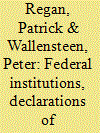

|
|
|
|
|
| Publication |
2013.
|
| Summary/Abstract |
Countries at civil war differ across a number of dimensions that are often used to account for onset, duration or severity. A relatively understudied dimension is the role of institutional arrangements on the severity of civil wars. We argue that federal systems put in place the mechanisms to make civil wars shorter but bloodier because they often allow for independent militia, taxation, and infrastructural development. Federal systems also make more credible a declaration of independence. These factors make civil wars looks much more like conventional warfare than their guerilla-based counterpart. We rely on the cases of Yugoslavia and the United States to build and describe our arguments and then we test our arguments against cross national data from the 20th century civil wars. Our results provide insights into the role of institutional arrangements on the management of internal conflicts and suggest that further research could make an important contribution to our understanding of civil wars.
|
|
|
|
|
|
|
|
|
|
|
|
|
|
|
|
| 14 |
ID:
024226
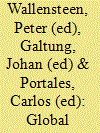

|
|
|
|
|
| Publication |
Colorado, Westview Press, 1985.
|
| Description |
xiv, 240p.
|
| Series |
Westview special studies in peace, conflict, and conflict resolution
|
| Standard Number |
0865316996
|
|
|
|
|
|
|
|
|
|
|
|
Copies: C:1/I:0,R:0,Q:0
Circulation
| Accession# | Call# | Current Location | Status | Policy | Location |
| 026516 | 355.0213/WAL 026516 | Main | On Shelf | General | |
|
|
|
|
| 15 |
ID:
033278
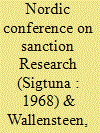

|
|
|
|
|
| Publication |
Uppasala, Uppasala University Department of peace and conflict research, 1968.
|
| Description |
121p.
|
| Series |
Report no.1
|
|
|
|
|
|
|
|
|
|
|
|
Copies: C:1/I:0,R:0,Q:0
Circulation
| Accession# | Call# | Current Location | Status | Policy | Location |
| 016623 | 327/WAL 016623 | Main | On Shelf | General | |
|
|
|
|
| 16 |
ID:
033268
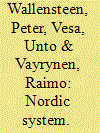

|
|
|
|
|
| Publication |
Uppsala, Uppsala University, Department of peace and conflict research, 1973.
|
| Description |
126p.
|
| Series |
Tampere of Peace Research Institute Research roports No.; 6
|
| Standard Number |
9517060084
|
|
|
|
|
|
|
|
|
|
|
|
Copies: C:1/I:0,R:0,Q:0
Circulation
| Accession# | Call# | Current Location | Status | Policy | Location |
| 016626 | 327.48/WAL 016626 | Main | On Shelf | General | |
|
|
|
|
| 17 |
ID:
112095
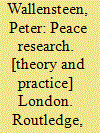

|
|
|
|
|
| Publication |
London, Routledge, 2011.
|
| Description |
xvi, 278p.Paperback
|
| Standard Number |
9780415580892
|
|
|
|
|
|
|
|
|
|
|
|
Copies: C:1/I:0,R:0,Q:0
Circulation
| Accession# | Call# | Current Location | Status | Policy | Location |
| 056407 | 303.66/WAL 056407 | Main | On Shelf | General | |
|
|
|
|
| 18 |
ID:
144315
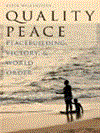

|
|
|
|
|
| Publication |
New York, Oxford University Press, 2015.
|
| Description |
xi, 250p.pbk
|
| Series |
Studies in Strategic Peacebuilding
|
| Standard Number |
9780190215552
|
|
|
|
|
|
|
|
|
|
|
|
Copies: C:1/I:0,R:0,Q:0
Circulation
| Accession# | Call# | Current Location | Status | Policy | Location |
| 058616 | 327.172/WAL 058616 | Main | On Shelf | General | |
|
|
|
|
| 19 |
ID:
043998
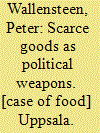

|
|
|
|
|
| Publication |
Uppsala, Uppsala University, 1976.
|
| Description |
39p
|
| Standard Number |
9150600583
|
|
|
|
|
|
|
|
|
|
|
|
Copies: C:1/I:0,R:0,Q:0
Circulation
| Accession# | Call# | Current Location | Status | Policy | Location |
| 016832 | 338.1973/WAL 016832 | Main | On Shelf | General | |
|
|
|
|
| 20 |
ID:
128875
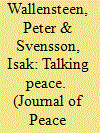

|
|
|
|
|
| Publication |
2014.
|
| Summary/Abstract |
Mediation, as a means to end armed conflicts, has gained prominence particularly in the past 25 years. This article reviews peace mediation research to date, with a particular focus on quantitative studies as well as on significant theoretical and conceptual works. The growing literature on international mediation has made considerable progress towards understanding the conditions under which mediation processes help bring armed conflicts to peaceful ends. Still, the field of international mediation faces a number of problems. In this article, we aim to identify findings on mediation frequency, strategies, bias, and coordination as well as on trends in defining success. Although previous research has generated important insights, there are still unresolved issues and discrepancies which future mediation research needs to explore. Many of the challenges that the field faces could be managed by giving greater attention to accumulative knowledge production, more disaggregated analysis, and a closer dialogue between policy and research.
|
|
|
|
|
|
|
|
|
|
|
|
|
|
|
|
|
|
|
|
|